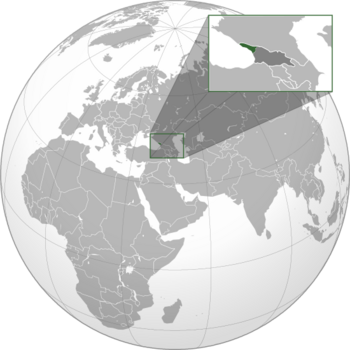Abkhazia facts for kids
Quick facts for kids
Republic of Abkhazia
|
|
|---|---|
|
Anthem: Аиааира (Abkhaz)
Aiaaira "Victory" |
|

Abkhazia (green) within Georgia (dark grey)
|
|
| Status | Partially recognised state |
| Capital and largest city
|
Sukhumi 43°0′0″N 41°1′40″E / 43.00000°N 41.02778°E |
| Official languages | |
| Spoken languages | |
| Demonym(s) |
|
| Government | Unitary presidential republic |
| Badra Gunba | |
| Beslan Bigvava | |
| Valeri Bganba (acting) | |
| Legislature | People's Assembly |
| Establishment | |
|
• Socialist Soviet Republic of Abkhazia
|
31 March 1921 |
|
• Abkhaz Autonomous Soviet Socialist Republic
|
19 February 1931 |
|
• Abkhazian declaration of sovereignty
|
25 August 1990 |
|
• Abkhazian declaration of independence
|
23 July 1992 |
|
• Act of state independence
|
12 October 1999 |
| Area | |
|
• Total
|
8,664.59 km2 (3,345.42 sq mi) |
| Population | |
|
• 2022 estimate
|
244,236 (180th) |
|
• 2011 census
|
240,705 |
|
• Density
|
28.2/km2 (73.0/sq mi) (160th) |
| GDP (nominal) | 2021 estimate |
|
• Total
|
$270 million |
|
• Per capita
|
$1,100 |
| Currency | (RUB) |
| Time zone | UTC+3 (MSK) |
| Driving side | right |
| Calling code | +7 840 / 940 (formerly, +995 44) |
Abkhazia is a de facto sovereign state that is internationally recognized as an autonomous republic of Georgia. It lies in the South Caucasus on the eastern coast of the Black Sea, south of the Greater Caucasus mountains in northwestern Georgia. It covers 8,660 square kilometres (3,340 sq mi) and has a population of around 240,000. Its capital is Sukhumi.
The status of Abkhazia is a central issue of the Georgian–Abkhazian conflict and Georgia–Russia relations. The polity is recognised as a state by Russia, Venezuela, Nicaragua, Nauru and Syria. While Georgia lacks control over Abkhazia, the Georgian government and most United Nations member states consider Abkhazia legally part of Georgia, whose constitution designates the area as the Autonomous Republic of Abkhazia.
The region had autonomy within Soviet Georgia at the time when the Soviet Union began to disintegrate in the late 1980s. Simmering ethnic tensions between the Abkhaz—the region's "titular ethnicity"—and Georgians—the largest single ethnic group at that time—culminated in the 1992–1993 War in Abkhazia which resulted in Georgia's loss of control of most of Abkhazia, the de facto independence of Abkhazia, and the ethnic cleansing of Georgians from Abkhazia.
Despite the 1994 ceasefire agreement and years of negotiations, the dispute remains unresolved. The long-term presence of a United Nations Observer Mission and a Russian-led Commonwealth of Independent States (CIS) peacekeeping force failed to prevent the flare-up of violence on several occasions. In August 2008, Abkhaz and Russian forces fought a war against Georgian forces, which led to the formal recognition of Abkhazia by Russia, the annulment of the 1994 ceasefire agreement, and the termination of the UN mission. On 28 August 2008, the Parliament of Georgia declared Abkhazia a Russian-occupied territory, with most United Nations member states concurring.
Images for kids
-
The borders of the Sukhumi District of the Kutaisi Governorate in 1899 when Abkhazia was part of the Russian Empire.
-
Abkhaz and Georgian generals in the Imperial Russian Army, 19th century
-
Seaside in Pitsunda, Abkhazia in 2006
-
Map of Georgia highlighting Abkhazia (green) and South Ossetia (purple).
-
Dmitry Medvedev (centre, with dark tie) visited the Russian military base in Gudauta in 2010
-
The leaders of Abkhazia, Russia and South Ossetia, shortly after the 2008 war. Left to right: South Ossetian President Eduard Kokoity; Russian President Dmitry Medvedev; Russian Foreign Minister Sergey Lavrov; Abkhazian President Sergei Bagapsh.
-
Abkhazian President Alexander Ankvab with Transnistrian President Yevgeny Shevchuk in September 2013
-
View from Pitsunda cape
-
Beach in Gagra in May 2014
See also
 In Spanish: Abjasia para niños
In Spanish: Abjasia para niños




















